Introduction
Nonwoven eco-friendly materials are becoming increasingly significant in today’s sustainability-focused world. As the global emphasis on environmental conservation intensifies, industries across various sectors are actively seeking out sustainable alternatives to traditional materials. Nonwoven materials, characterized by their unique fabrication process that bonds fibers together without weaving, present a promising solution. These eco-friendly variants are designed to minimize environmental impact throughout their lifecycle, from production to disposal.
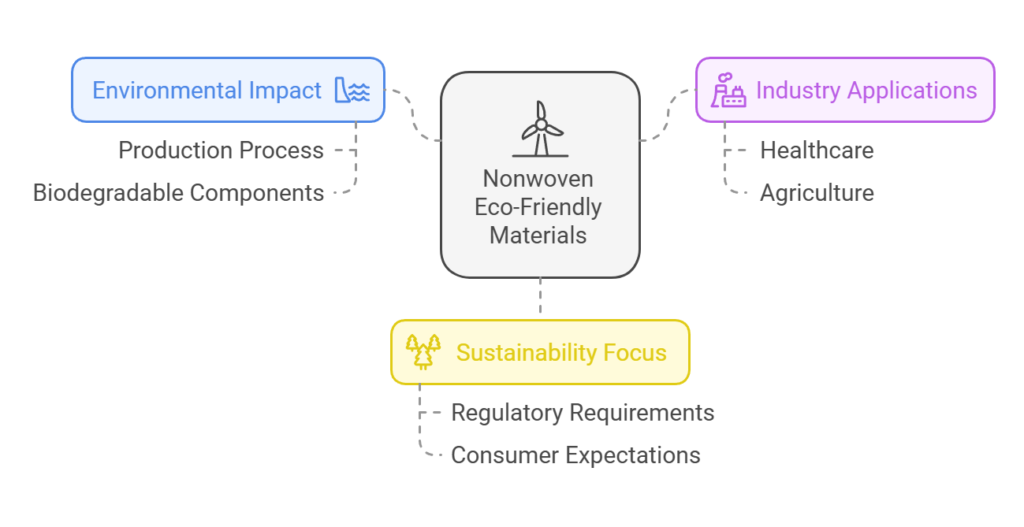
One of the primary reasons behind the growing interest in nonwoven eco-friendly materials is the urgent need to address pressing environmental concerns. Traditional materials, particularly those derived from non-renewable resources, often have significant adverse effects on ecosystems. Conversely, nonwoven materials can be engineered from renewable sources and biodegradable components, reducing their ecological footprint. This aspect is particularly crucial as industries seek to meet regulatory requirements and consumer expectations for responsible and sustainable practices.
The versatility of nonwoven eco-friendly materials further contributes to their importance. They are being adopted in a myriad of applications, ranging from healthcare and hygiene products to agricultural and geotextile solutions. In healthcare, for example, nonwoven eco-friendly materials provide the necessary functionality and hygiene, while also offering an environmentally conscious alternative. In agriculture, these materials are utilized for crop protection and soil stabilization, demonstrating their multifunctionality and relevance.
Overall, the shift towards nonwoven eco-friendly materials signifies a broader movement towards sustainable development. By integrating these materials into production processes, industries not only contribute to environmental conservation but also enhance their corporate social responsibility profiles. As global awareness and regulatory pressures continue to rise, the adoption and innovation of nonwoven eco-friendly materials are expected to grow, underscoring their critical role in shaping a more sustainable future.
What Are Nonwoven Eco-Friendly Materials?
Nonwoven eco-friendly materials are innovative textiles that differ significantly from traditional fabrics or synthetic materials. Unlike conventional textiles, which are woven or knitted from threads, nonwoven materials are produced by bonding fibers together using chemical, mechanical, heat, or solvent means. This manufacturing process not only reduces production time but also minimizes waste and energy consumption, making it more environmentally friendly.
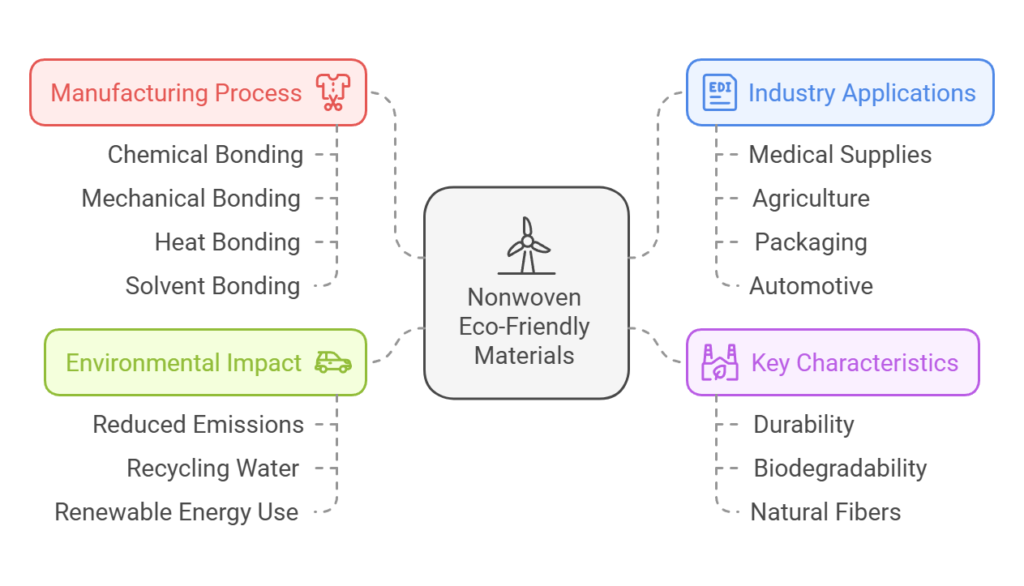
Key characteristics of nonwoven eco-friendly materials include durability, biodegradability, and a lower environmental footprint. These materials are often composed of natural fibers like cotton, bamboo, or recycled polymers, which enhance their sustainability quotient. Additionally, the manufacturing process typically avoids harmful chemicals and utilizes renewable energy sources, further contributing to their eco-friendly nature.
The eco-friendly manufacturing process integrates practices such as reducing emissions, recycling water, and utilizing less energy, setting these materials apart from traditional, more polluting textile production methods. As the demand for sustainable products continues to grow, nonwoven eco-friendly materials are increasingly replacing conventional options in various industries, ranging from medical supplies to agriculture, packaging, and automotive sectors.
Types of Nonwoven Eco-Friendly Materials
Nonwoven eco-friendly materials have been increasingly adopted across various industries due to their environmental benefits and diversified applications. Understanding the different types of these materials can help stakeholders make informed decisions regarding their use. This section highlights some prominent examples such as biodegradable fabrics, recycled PET nonwovens, and plant-based fibers.
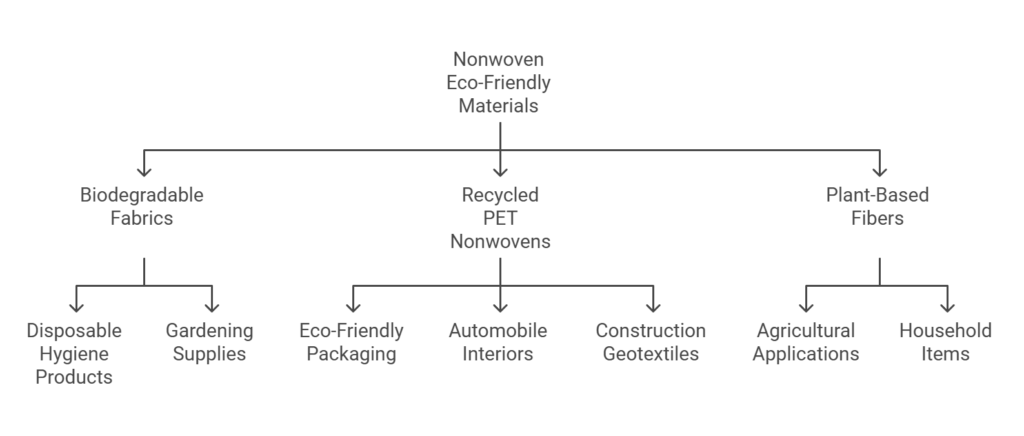
Biodegradable Fabrics: One of the most popular types of nonwoven eco-friendly materials is biodegradable fabrics. Made from natural fibers such as bamboo, cotton, and wool, these fabrics have the ability to decompose naturally when disposed of, reducing landfill waste. The key properties of biodegradable fabrics include high moisture absorption, breathability, and softness. Common uses span across disposable hygiene products like diapers and sanitary napkins, as well as gardening supplies including mulch films.
Recycled PET Nonwovens: Another significant type of eco-friendly material is recycled PET (Polyethylene Terephthalate) nonwovens. These materials are derived from recycled plastic bottles, offering a sustainable alternative to virgin synthetic fibers. Recycled PET nonwovens are characterized by their remarkable durability, resistance to tear, and lightweight nature. Industries utilize these materials for producing eco-friendly packaging, automobile interiors, and construction geotextiles that require robust structural integrity.
Plant-Based Fibers: Plant-based fibers such as jute, flax, and hemp have been increasingly integrated into nonwoven fabrics due to their renewable nature and minimal environmental impact. These fibers are biodegradable and possess excellent strength and insulating properties. Key uses of plant-based fibers include agricultural applications like seed mats and erosion control, as well as household items such as cleaning wipes and tablecloths.
Incorporating these various types of nonwoven eco-friendly materials not only contributes to environmental sustainability but also ensures that the end-products meet the specific needs of their diverse applications. The versatility and earth-friendly traits of these materials make them a favorable choice for companies looking to adhere to green practices while delivering high-performance products.
Applications and Uses
Nonwoven eco-friendly materials have found extensive applications across a wide range of industries, thanks to their versatility and sustainable nature. In the healthcare sector, these materials are indispensable for manufacturing disposable medical supplies such as surgical gowns, masks, and drapes. These products not only offer high levels of hygiene and barrier protection but are also increasingly designed to be biodegradable, minimizing environmental impact. Advanced innovations in this field have led to the development of antimicrobial nonwoven fabrics, further enhancing patient safety.
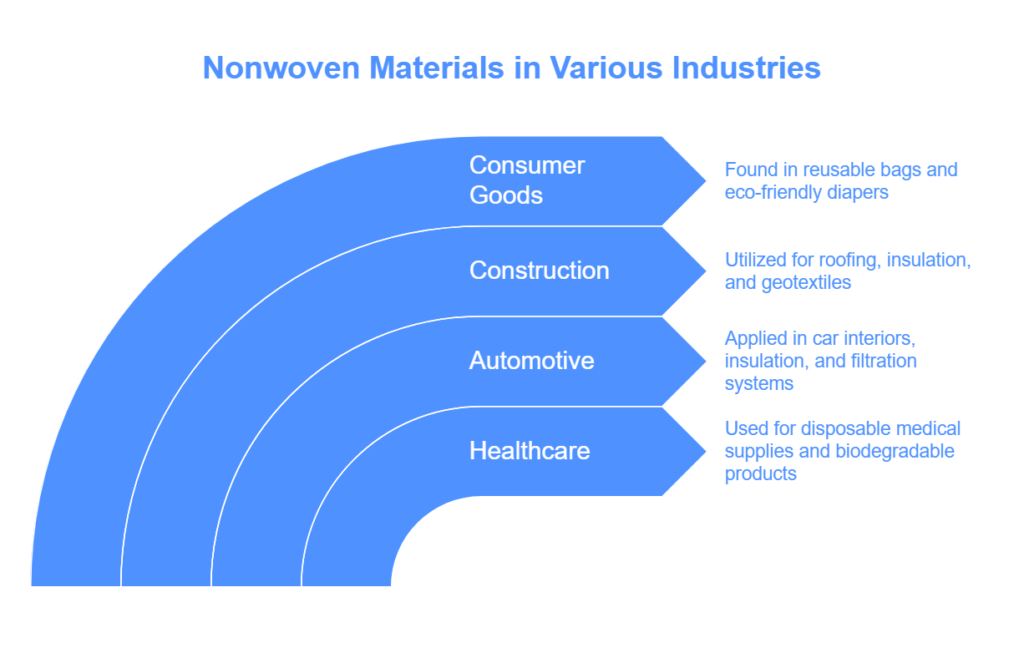
The automotive industry also greatly benefits from nonwoven eco-friendly materials. They are used in various components, including car interiors, insulation, and filtration systems. For example, eco-friendly nonwoven fabrics are employed in car seat upholstery, headliners, and trunk linings due to their lightweight and durable nature. These materials help in reducing the overall vehicle weight, thereby improving fuel efficiency and reducing carbon emissions.
In the construction industry, nonwoven eco-friendly materials are utilized for tasks such as roofing, insulation, and geotextiles. Their application in geotextiles supports soil stabilization and erosion control while promoting sustainable construction practices. Additionally, nonwoven fabrics used in roofing underlays and house wraps offer excellent moisture management and air barrier properties, contributing to energy-efficient building designs.
Consumer goods have also embraced nonwoven eco-friendly materials in a myriad of products. From reusable shopping bags to eco-friendly diapers, these materials are paving the way for greener consumer choices. In the fashion industry, nonwoven fabrics are used to produce sustainable clothing and accessories, offering alternatives to traditional textiles reliant on resource-intensive processes.
These examples highlight the transformative impact of nonwoven eco-friendly materials across various industries, showcasing their potential to drive sustainable innovation and reduce environmental footprints. As technology and material science continue to advance, we can anticipate even broader and more innovative applications of these sustainable materials in the future.
Benefits of Nonwoven Eco-Friendly Materials
Nonwoven eco-friendly materials present numerous advantages, both environmentally and practically, making them a compelling alternative to traditional materials. One of the significant environmental benefits is their contribution to reducing waste. Nonwoven materials are often engineered from renewable resources and recycled fibers, decreasing the dependence on virgin materials. This aspect not only mitigates the generation of waste but also promotes a sustainable supply chain.

Another crucial advantage is the reduction in carbon footprint. The production processes for nonwoven materials tend to consume less energy and emit fewer greenhouse gases compared to conventional methods. Consequently, adopting nonwoven eco-friendly materials supports efforts to combat climate change by minimizing atmospheric pollution.
Enhancing product life cycles is an additional benefit of these materials. Nonwoven fabrics are designed to be robust and long-lasting, which translates to fewer replacements and disposals over time. This durability significantly reduces the environmental impact associated with frequent manufacturing and waste disposal processes. Furthermore, the versatility of nonwoven materials ensures they can be adapted for diverse applications, ranging from automotive interiors to medical products, thus broadening their utility.
From a practical standpoint, nonwoven eco-friendly materials offer cost-effectiveness. The production efficiency of nonwoven processes often results in lower manufacturing costs compared to woven fabrics. In addition, because these materials can be made from locally sourced renewable or recycled resources, they foster economic sustainability by reducing reliance on imported raw materials.
Durability is another notable benefit. Nonwoven fabrics can withstand wear and tear, making them highly suitable for demanding applications. Their adaptable performance also ensures that these materials can meet stringent industry standards and functional requirements, whether for hygiene products, geotextiles, or consumer goods.
Overall, the benefits of nonwoven eco-friendly materials extend beyond environmental impact, encompassing cost savings, enhanced durability, and superior adaptability. These factors collectively underscore the value of embracing nonwoven solutions in a variety of sectors.
Challenges and Limitations
While nonwoven eco-friendly materials offer numerous benefits, they are not without their challenges and limitations. One of the primary concerns lies in the cost of production. Developing eco-friendly alternatives often involves investing in new technologies and processes, which can be cost-prohibitive for smaller manufacturers. This can result in higher prices for end consumers, deterring market acceptance and widespread adoption of these materials.
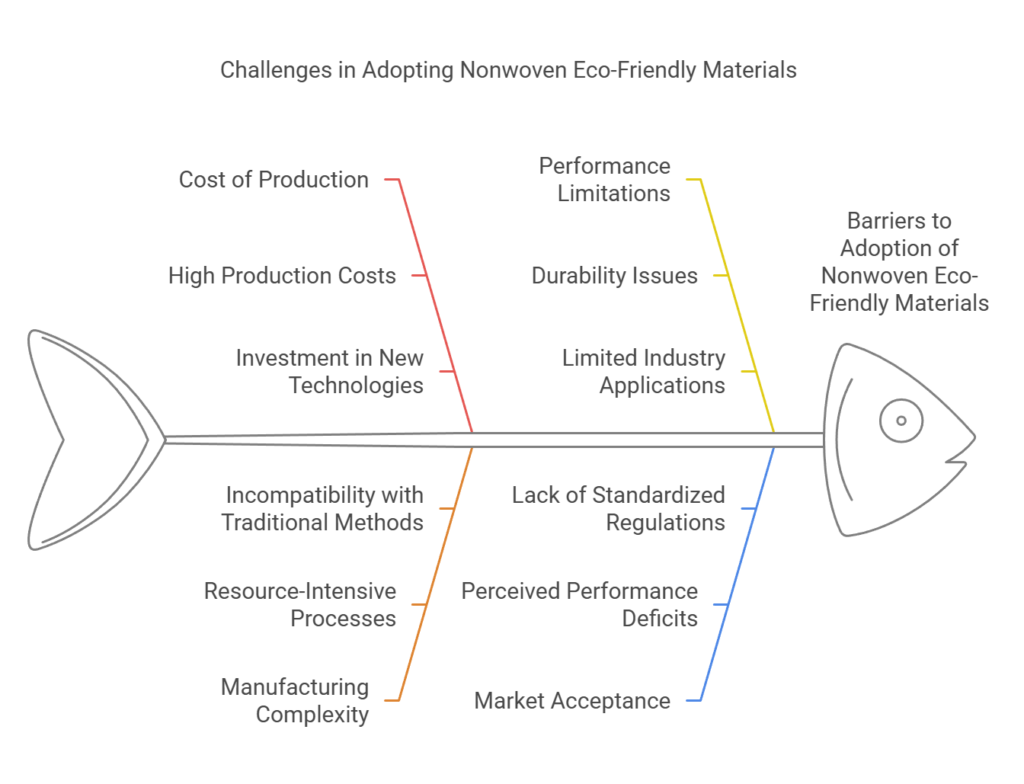
The manufacturing process of nonwoven eco-friendly materials can also be complex and resource-intensive. Traditional methods may not be compatible with sustainable alternatives, necessitating a complete overhaul of existing production lines. This transition requires significant capital investment and can disrupt established manufacturing workflows. Additionally, procuring raw materials that meet stringent environmental standards can be challenging due to limited availability and higher costs.
Performance limitations are another significant hurdle. Nonwoven eco-friendly materials may not always match the durability and functionality of their conventional counterparts. For example, in applications requiring high tensile strength or resistance to extreme conditions, eco-friendly options might underperform. This performance gap can restrict their use in specific industries and applications, limiting their market penetration.
Market acceptance remains a pivotal bottleneck. Despite growing awareness about environmental issues, many consumers and industries are hesitant to transition to eco-friendly alternatives due to perceived performance deficits and higher costs. Moreover, the lack of standardized regulations and certifications can create confusion and mistrust, further impeding acceptance. Marketing these materials necessitates a fine balance between educating consumers on the benefits and addressing concerns related to performance and cost.
In summary, while nonwoven eco-friendly materials represent a significant stride towards sustainability, overcoming these challenges is crucial for their broader adoption. Addressing cost barriers, streamlining manufacturing processes, ensuring performance reliability, and fostering market acceptance are essential steps in driving the future of environmentally responsible material solutions.
Future Trends and Innovations
The trajectory of research and development in nonwoven eco-friendly materials indicates a promising future characterized by technological advancements and novel materials. Keeping sustainability at the fore, emerging technologies are set to enhance the functionality and eco-compatibility of nonwoven materials, addressing current limitations such as biodegradability and material strength. One significant area of innovation lies in the utilization of bio-based polymers and natural fibers, which are poised to replace synthetic options, thereby reducing environmental impact.
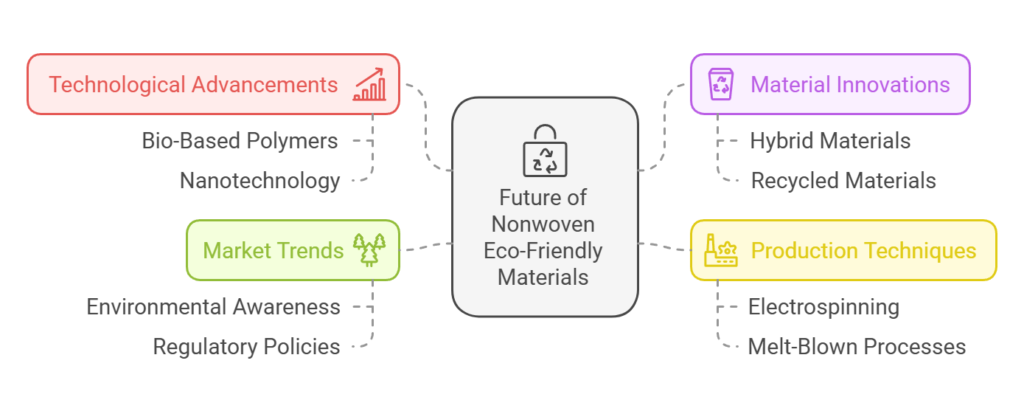
Leading the charge are biopolymers like polylactic acid (PLA), derived from renewable resources such as corn starch. These materials are not only compostable but also exhibit mechanical properties comparable to petroleum-based polymers. Furthermore, advancements in nanotechnology are enabling the development of nanoscale fibers that are not only lightweight but also exhibit superior strength and durability. Researchers are also exploring hybrid materials, combining the best properties of natural and synthetic fibers to prolong the lifecycle and performance of the products they constitute.
Another trend gaining traction is the incorporation of recycled materials into nonwoven fabrics. This approach not only champions resource conservation but also offers a practical solution to waste management concerns. Innovations in recycling technologies are making it feasible to reprocess post-consumer waste into high-quality nonwoven materials without compromising their performance characteristics.
From a technological standpoint, advancements in production techniques such as electrospinning and melt-blown processes are notable. These methods contribute to a marked improvement in the fine-tuning of fiber diameters and material properties, which are essential for specialized applications ranging from medical products to filtration systems. The adoption of Industry 4.0 principles, including automation and IoT integration, is set to revolutionize the manufacturing landscape, enhancing efficiency and precision in the production of nonwoven eco-friendly materials.
Market forecasts suggest a steadily growing demand for nonwoven eco-friendly materials, driven by increasing environmental awareness and stringent regulatory policies. Enterprises investing in sustainable innovation are likely to enjoy a competitive edge, translating to higher market shares and consumer trust. As advancements continue, nonwoven eco-friendly materials are expected to play a crucial role in the transition towards a more sustainable future across various industries, from packaging to apparel.
FAQs
Understanding nonwoven eco-friendly materials can be quite intricate. Here, we address some frequently asked questions to provide clarity on this subject.
How are nonwoven materials different from woven fabrics?
Nonwoven materials differ primarily in their manufacturing process. Unlike woven fabrics, which are produced by interweaving yarns, nonwoven materials are made directly from fibers that are bonded together through mechanical, chemical, or thermal means. This results in a fabric that is typically lighter, more durable, and often more cost-effective to produce. Moreover, nonwoven materials can be engineered to possess specific characteristics, such as water resistance or breathability, which make them suitable for a variety of applications.
Are nonwoven eco-friendly materials compostable?
Whether a nonwoven material is compostable depends on the fibers and bonding agents used in its production. Many eco-friendly nonwovens are designed to be biodegradable or compostable, utilizing natural fibers such as cotton, bamboo, or biodegradable polymers. However, not all nonwoven materials fit this category. It is crucial for consumers to look for certifications and labels that specify the compostability of the product to ensure proper disposal and environmental benefits.
Which industries are leading in the use of eco-friendly nonwovens?
The adoption of eco-friendly nonwovens is growing across several industries. The medical sector is a significant user, employing these materials in disposable gowns, masks, and surgical drapes due to their hygiene and low-cost effectiveness. The automotive industry also utilizes eco-friendly nonwovens for car interiors and filters, contributing to lighter and more fuel-efficient vehicles. Additionally, the fashion and textile industry is increasingly integrating sustainable nonwovens in clothing and footwear to meet consumer demand for sustainable products.
How can consumers identify eco-friendly nonwoven products?
Consumers can identify eco-friendly nonwoven products by looking for specific certifications and labels that denote environmental friendliness, such as the Global Organic Textile Standard (GOTS), OEKO-TEX® Standard 100, or the Biodegradable Products Institute (BPI) certification. Additionally, consumers should be aware of the materials listed in the product description, favoring those made from natural or biodegradable fibers. Companies often highlight their sustainability efforts, which can guide consumers toward more eco-conscious choices.


79 Responses
Real Estate For the reason that the admin of this site is working, no uncertainty very quickly it will be renowned, due to its quality contents.
Thank you for your support and recognition – it means a great deal to me. Together, let us continue on this journey of sharing knowledge and wisdom for the betterment of all.
Real Estate For the reason that the admin of this site is working, no uncertainty very quickly it will be renowned, due to its quality contents.
Thank you for your kind words! I’m thrilled to hear you enjoyed the post. Your appreciation means a lot. Stay tuned for more content!
Fourweekmba Pretty! This has been a really wonderful post. Many thanks for providing these details.
Thank you for your kind words! I’m thrilled to hear you enjoyed the post. Your appreciation means a lot. Stay tuned for more content!
Hey, I’m Jack. Your blog is a game-changer! The content is insightful, well-researched, and always relevant. Great job!
I have been surfing online more than 3 hours today yet I never found any interesting article like yours It is pretty worth enough for me In my opinion if all web owners and bloggers made good content as you did the web will be much more useful than ever before
Thank you for your kind words! Glad you enjoyed the article. 😊
Thanks I have recently been looking for info about this subject for a while and yours is the greatest I have discovered so far However what in regards to the bottom line Are you certain in regards to the supply
Thank you for your compliment. We are confident about the supply. 😊
I have read some excellent stuff here Definitely value bookmarking for revisiting I wonder how much effort you put to make the sort of excellent informative website
Thank you for your kind words! Glad you find our website useful. 😊
The unique viewpoints in The writing never fail to impress me. Insightful as always!
Thanks for your compliment! Glad you like it. 😊
Stumbling upon The article was a highlight of my day. It was just what I needed to read.
Glad you enjoyed the article! 😊
A masterpiece of writing. Van Gogh’s got nothing on you, except maybe both ears.
Thank you for your compliment! 😊
The thoughtful analysis has really made me think, in a way that’s as stimulating as a deep gaze into The eyes.
Your comment is inspiring! The article on http://www.non-woven.com is indeed thought-provoking. Looking forward to more such engaging discussions.
The effort you’ve put into this post is evident and much appreciated. It’s clear you care deeply about The work.
Thank you for your kind words! Glad you liked the post. 😊
Brilliant writing! You’ve perfectly captured the essence of the topic.
Thank you! Glad you liked it.
Handling topics with grace and authority, like a professor, but without the monotone lectures.
Impressive! This article truly showcases grace and authority. Looking forward to more such engaging content.
Nonwoven eco-friendly materials are gaining popularity as industries seek sustainable alternatives. Made from renewable and biodegradable sources, these materials reduce environmental impact by avoiding harmful traditional materials. Their versatility spans healthcare, where they offer hygienic yet eco-conscious solutions, to agriculture, where they aid in crop protection and soil stabilization, highlighting their multifunctional benefits.
Agreed! Nonwoven eco-friendly materials are indeed a great choice for a sustainable future. 😊
The commitment to high quality content really shows. I’m always excited to read The work.
Thanks for your kind words! We’ll keep providing high-quality content.
Adding value to the conversation, because what’s a discussion without The two cents?
Great point! Your comment truly adds value. Looking forward to more engaging discussions.
It’s exhausting to search out knowledgeable individuals on this matter, but you sound like you recognize what you’re talking about! Thanks
Thanks for your compliment! Glad to be of help.
The Writing is a go-to resource for me. Thanks for all the hard work!
Thanks for your comment! Glad it’s helpful. 😊
The way you break down ideas is like a chef explaining a recipe, making hard to understand dishes seem simple.
Thank you for your kind words! Glad my article could help. 😊
I all the time emailed this website post page to all my contacts, for the reason that if like to read it next my links will too.
Thanks for sharing! Glad you find our website useful. 😊
The writing captivated me from the first paragraph to the last. It’s rare to find such engaging content.
Thank you for your kind comment! Glad you enjoyed it.
The knack for making hard to understand concepts readable is something I greatly admire.
Thanks for your compliment! We will keep working hard to provide more valuable content.
The Writing is a constant source of inspiration and knowledge for me. I can’t thank you enough.
Thank you for your kind words! Glad to be of inspiration and knowledge. 😊
I learned a lot, and now I’m curious about what else you could teach me. The intelligence is as captivating as The prose.
Thank you for your kind words! I’m glad you found it useful. There’s always more to learn. Stay tuned for more insights. 😊
The writing style is like a signature scent—distinct, memorable, and always pleasant.
Thank you! I’m glad you like the writing style and find it distinct and pleasant.
Beautifully written and informative, making the rest of the internet look bad.
Thank you! I’m glad you found the content valuable and well-written.
Touched on personal resonances, or as I like to call it, psychic abilities.
I’m not sure what you mean by this comment. Maybe you could explain it further?
You’ve done a fantastic job of breaking down this topic, like unlocking a door to a secret garden. Intrigued to explore more.
Thank you so much for your kind and inspiring words! I’m glad you found the content engaging and valuable. Stay tuned for more exciting insights and discoveries.
I find myself lost in The words, much like one would get lost in someone’s eyes. Lead the way, I’m following.
Thank you! Your words are as captivating as the content we strive to create. We’ll keep blazing the trail, and we’re thrilled to have you on this journey with us.
Noodlemagazine I truly appreciate the effort you’ve made, thanks for delivering such fantastic content
We’re thrilled to hear that this is your first visit to http://www.non – woven.com and that you’re finding the site convenient. Your positive feedback means a lot to us. We strive to provide a one – stop – shop experience for all things non – woven. We hope you’ll continue to explore our articles and resources, and we look forward to serving you in the future!
FlixHQ I’m new to blogging, and I find your content genuinely inspiring. This post especially caught my eye. I’ll bookmark your site and regularly check for updates.
Thank you so much for your kind words! We’re thrilled to hear that you’re new to blogging and that our content has inspired you. It’s great to know this post caught your attention. We look forward to having you as a regular visitor. If you have any questions or topics you’d like to see covered, feel free to let us know.
Thank you for adding value to the conversation with insights on the state of the country.
You’re welcome! Glad you found the insights valuable. Looking forward to more engaging discussions about the non – woven industry and its connection to broader aspects like the state of the country.
Every post of yours is a learning opportunity for me on the state of the country. Thanks for sharing the expertise.
Dear reader, thank you so much for your honest feedback. We truly appreciate your long – time support and the fact that you’ve been following our content. We understand your concerns about the recent posts. Our team is already working on refreshing our approach to ensure the articles are as engaging and high – quality as the ones you loved before. Stay tuned, and we’re confident you’ll find the upcoming content more to your liking.
The Writing is a treasure trove of knowledge, like finding an untouched library book. A rare gem!
Thank you so much! We’re thrilled you find our content valuable, just like a hidden gem. Stay tuned for more insights.
I was truly impressed by how deeply you delved into this topic. The hard work hasn’t gone unnoticed!
Thank you so much for your kind words! We’re thrilled that you found the information useful. Looking forward to having you back for more content.
The creativity and intelligence shine through, blinding almost, but I’ll keep my sunglasses handy.
Thank you so much! We’re thrilled you think our content is that creative and intelligent. Hope you continue to enjoy and find more “eye – opening” reads on our site.
The words are like brush strokes on a canvas, painting ideas in my mind.
Thank you so much for your beautiful comment! We’re thrilled that our article inspired such vivid imagery for you.
You’ve done a fantastic job of breaking down this topic, like unlocking a door to a secret garden. Intrigued to explore more.
Thank you so much! Delighted you found it engaging. Stay tuned for more!
I regret, that I can help nothing. I hope, you will find the correct decision. Do not despair.
Thank you for your comment and encouragement! We appreciate your support and will keep striving to find the right solutions.